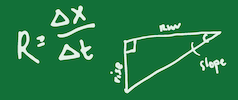Guiding Students through Exponential Equations
An Instructor's Guide to Exponential Equations
Rory McFadden (Science Education Resource Center)
Eric Baer (Highline College)
What Should Students Get out of This Module?
The purpose of this module is to introduce exponential equations to students and provide example problems in the context of Earth science. The module is meant to be preliminary practice to prepare students for more complex problems you may assign in your course. After completing this module, a student should be able to:
- Use algebraic methods to rearrange exponential equations
- Determine a geologically reasonable value using exponential equations
- Recognize the wide variety of Earth science problems that include exponential equations
- Analyze exponential growth and exponential decay curves on a graph
Why Are These Math Skills Challenging to Incorporate into Courses?
These topics are commonly introduced in college algebra, pre-calculus, or calculus where there is limited Earth science context. Students have likely had limited exposure to exponential equations, and they have not been taught to recognize the utility of the equations. Mathematical methods such rearranging the equations that require logarithms, solving the equations, and visualizing equations takes consistent practice and most curricula do not provide sufficient opportunities for students to hone their skills with problems applied to Earth science. The lack of exposure in different classes and different contexts makes transfer of skills more challenging. In addition, notation varies. For example, different sources use 'exp(3)' or 'e3'. Students also may not remember the rules for working with exponents (e.g., 105 x 102 = 10(5+2) = 107) or logarithms. Using a calculator or Excel may introduce additional problems with order of operations or accurate formula notation.
What We Don't Include in the Page?
We do not discuss differential equations or integral calculus even though exponential growth and decay are described by differential equations and integrals. When there are multiple unknown terms, exponential equations require regression analysis with log or semi-log plots. We determined that regression analysis was beyond the scope of this module. We also do not use the word function even though it is in some cases the more appropriate term. All of the questions in this module use e and ln because these are the most common type of exponential equations used in the Earth sciences. There are certainly additional examples instructors could include in base 10 or base 2.
Instructor Resources
Support for teaching this quantitative skill
- Exponential Growth and Decay is a module by Jennifer Wenner from the Teaching Quantitative Skills in the Geosciences Project. The module explains the equations for exponential growth and decay, and it provides teaching strategies for instructors.
- VisionLearning, an online open educational resource for science educators and students, includes web pages on exponential equations by Anne Egger, Janet Shiver, and Teri Willard
Examples of activities that use this quantitative skill
- Growth and Population Dynamics is a reading from Kristen Menking within the Modeling Population Dynamics unit created for an InTeGrate module. The reading introduces the factors that influence population growth and decline over time. It includes numerous examples and steps through the mathematics of population growth.
- The IGUaNA project includes a module by Sarah Kruse and Christine Downs on ground penetrating radar for forensic geophysics. Problems within the units use the attenuation equation and provide a wealth of explanation and utility of ground penetrating radar.
